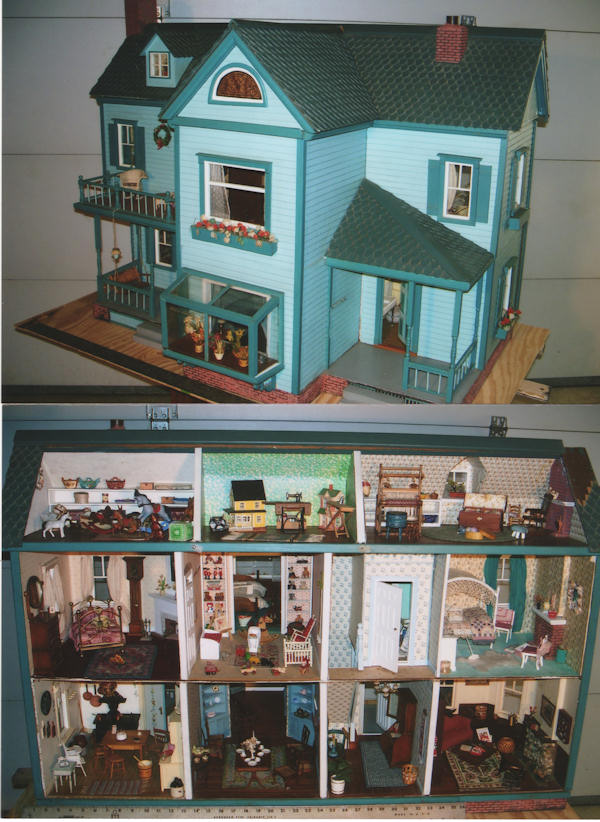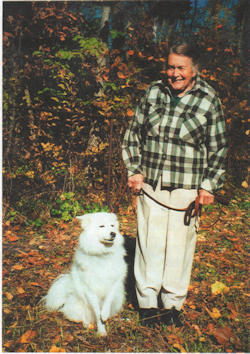Birgit Rennenkampff made this beautiful dollhouse. This is her extraordinary story. 
Birgit was born in rural Estonia on July 24 1917. She was the oldest of seven children born to the Welding family. Her father over time was the manager of several large farms. The Weldings belonged to the German minority in Estonia, and Birgit attended the German high school.
In 1935, she married Andreas Rennenkampff, son of landowners in Wesenberg and a teacher of mathematics. In 1937, their first child, Ingetraud, was born, followed by her brother Jurgen in 1938.
In 1939, as a consequence of the Hitler-Stalin Pact, Estonia became part of the Soviet Union and most of the German population was moved to Western Poland, which became part of Nazi Germany. The family settled in a small Silesian town called Niesky, where Andreas found work as a mathematics teacher. Niesky is quite an unusual place; it is a settlement established in the 18th century by the pietistic sect that called itself ‘Moravian Brotherhood’, and the school where Andreas taught was a boarding school for the sons of the Moravian missionaries.
 In January 1945 Silesia was conquered by Russian troops, and most of the population fled. Birgit’s family, five children and several other relatives, spent three days on a freight train that ultimately took them to Helmbrechts, a small town in Bavaria, where they stayed for several months. These months, just before and just after the end of the war, were perhaps the hardest period for the surviving civilian population—there was not enough food, nor fuel, nor medical supplies and many people died of commonplace diseases. Birgit lost her husband and the three youngest children. She also lost her parents, who perished during the flight from the East, and two brothers.
In January 1945 Silesia was conquered by Russian troops, and most of the population fled. Birgit’s family, five children and several other relatives, spent three days on a freight train that ultimately took them to Helmbrechts, a small town in Bavaria, where they stayed for several months. These months, just before and just after the end of the war, were perhaps the hardest period for the surviving civilian population—there was not enough food, nor fuel, nor medical supplies and many people died of commonplace diseases. Birgit lost her husband and the three youngest children. She also lost her parents, who perished during the flight from the East, and two brothers.
In the Summer of 1945 Birgit and her two remaining children traveled North to Bueckeburg, near Hanover, where a number of relatives, all of whom had fled from the East, were settling.
During the post-war years many Americans decided to help destitute Europeans, and three Madison families began sending packages to Birgit. Sometimes these were the famous CARE packages, which had standardized content, and sometimes these were packages containing more personal items, mostly clothing and food. As a result a correspondence started and soon the Madison families decided that they would sponsor Birgit’s immigration. And so it was in 1951 that Birgit, 14-year-old Ingetraud, and 13-year old Jurgen came to Wisconsin. A furnished apartment awaited them, with rent paid for three months. Birgit started working at Madison General Hospital as a housekeeper, and eventually became supervisor. She subsequently had other jobs at the Martin Luther Children’s Home and later at the Wisconsin State Hospital.
In 1961 she bought a building lot on Sand Hill Road, in the town of Dunn, and had a modest one-bedroom home built, every detail of which she designed herself. Here she expressed her love for flowers and gardening, creating and constantly expanding a lush perennial garden, as well a large vegetable plot. She was always on the lookout for interesting wildflowers, which she transplanted into her garden and the wood lot. Birgit loved animals. For many years she maintained a kennel of huskies and many stray or injured animals found a home with her. Over the years uncounted dogs, cats, raccoons, goats, sheep, and even a horse could be found at Birgit’s. She was an accomplished craftsperson and particularly adept at knitting and wood-carving.
Through these activities, as well as her active membership in the Oregon Senior Center, she made many friends. At the Center, she was well known for her hobby—making miniature scenes and dollhouses. She donated several works to the Sr. Center for raffle prizes. She also donated many items to the Center’s gift shop.
Birgit was also an amazing volunteer. For over twenty years, she delivered Meals on Wheels, her last delivery being just two days before her peaceful death at 89.
She leaves behind two children, Ingetraud (Gottfried), and Jurgen; 3 grandchildren, Kirsten Brieger (Michael Rothenberg), Michael Brieger (Lenore), and Julia Rennenkampff, and two great-grandchildren, Jake Rothenberg and Nicholas Brieger, 2 sisters, Dagny Paulsdottir and Elske Schwartz, and a brother, Ben Welding.
Birgit was know to be an outspoken person and sometimes had strong opinions on current events. She came from a sturdy tradition of self-sufficiency and was a model of voluntary simplicity in her life.
